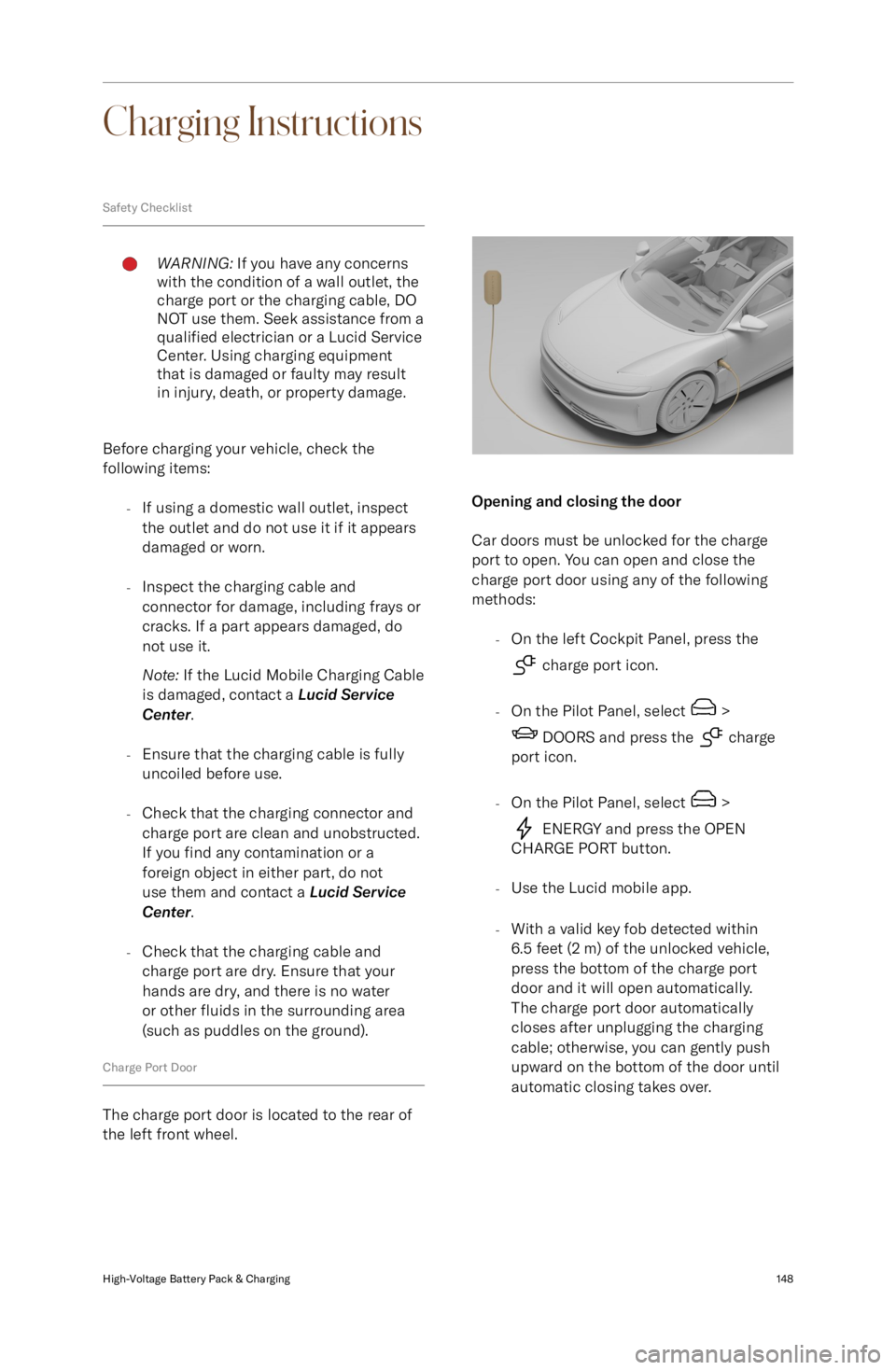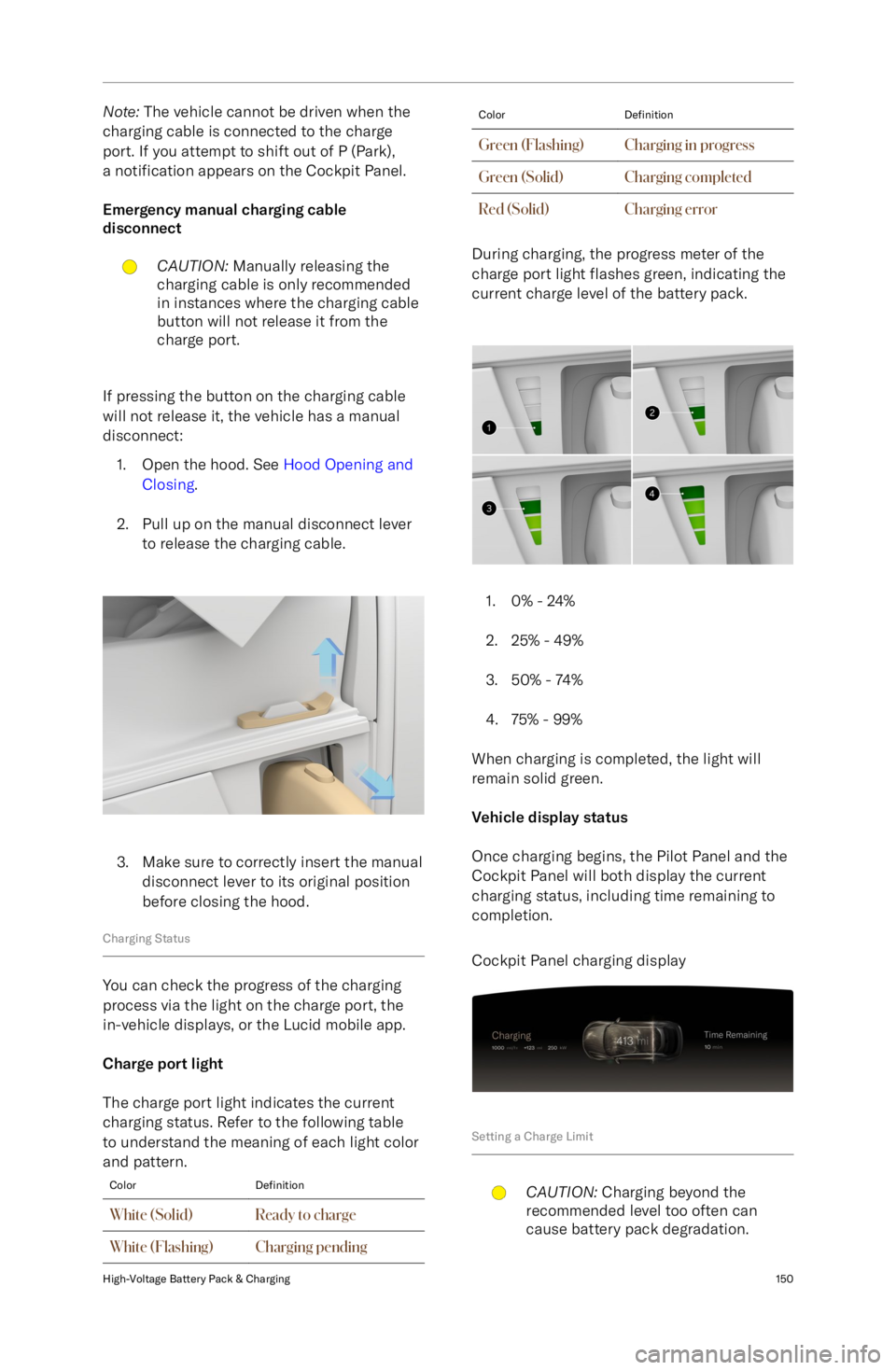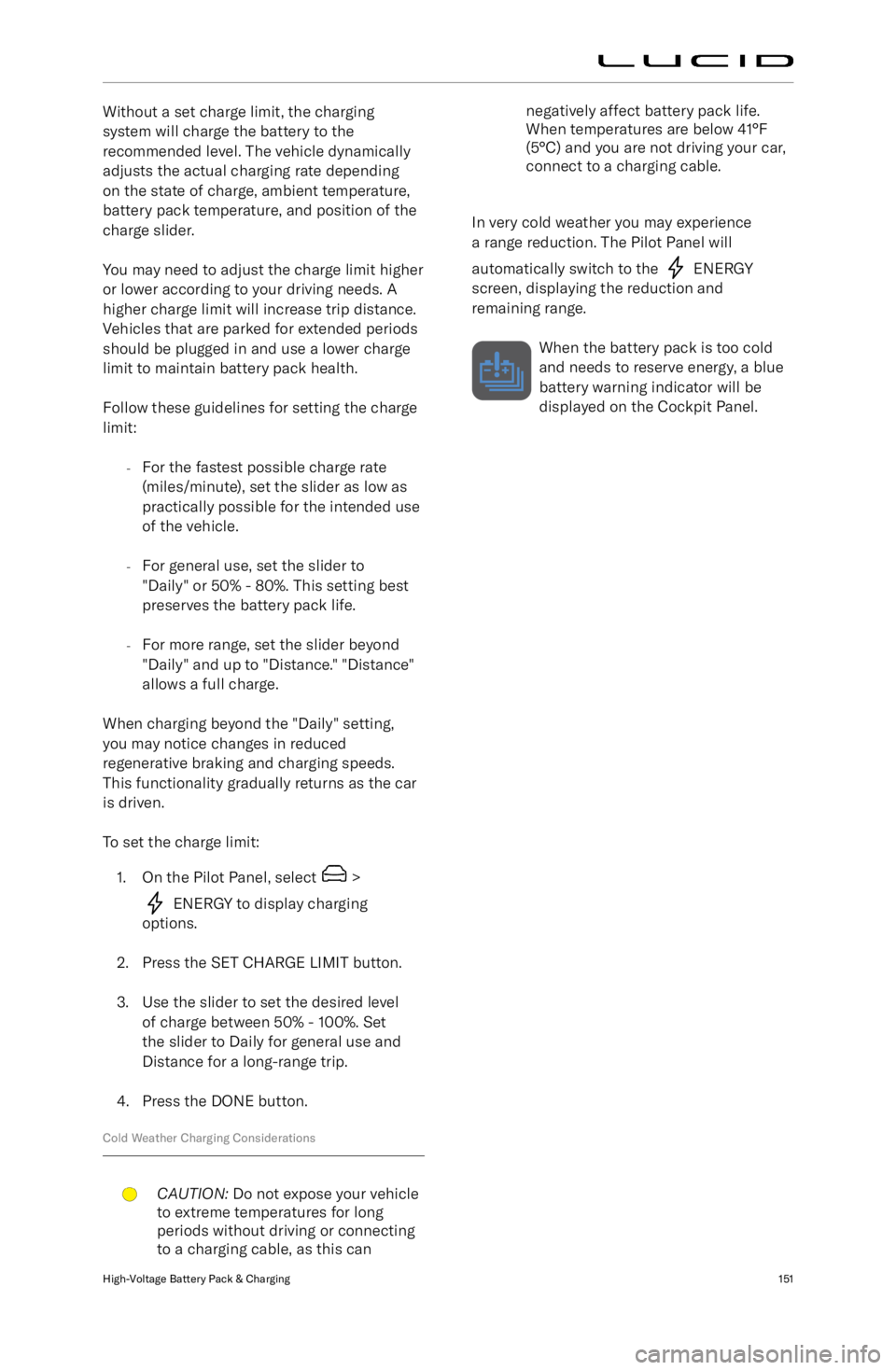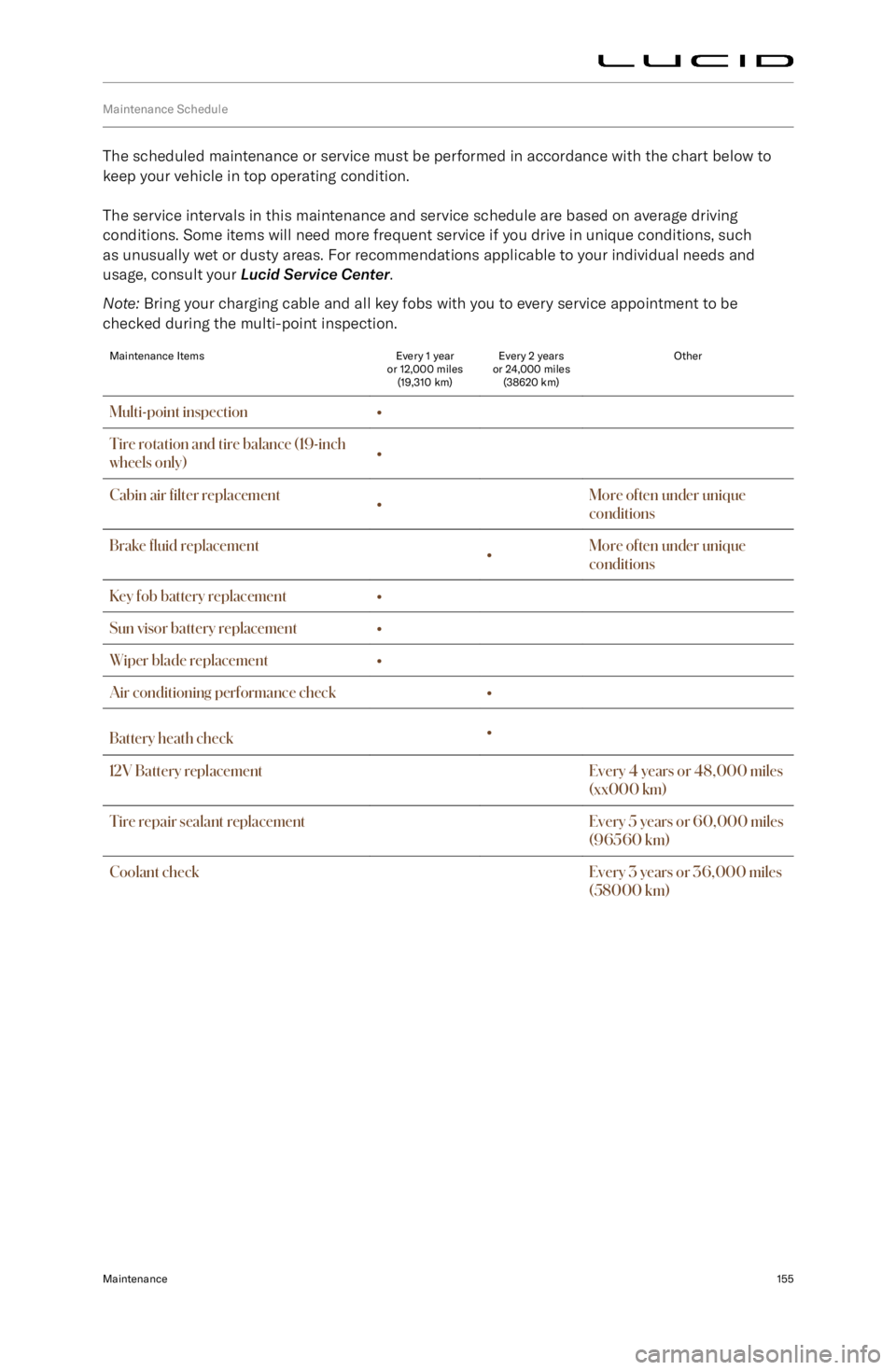LUCID AIR 2023 Owners Manual
Manufacturer: LUCID, Model Year: 2023, Model line: AIR, Model: LUCID AIR 2023Pages: 241, PDF Size: 5.15 MB
Page 161 of 241

Charging Instructions
Safety ChecklistWARNING: If you have any concerns
with the condition of a wall outlet, the
charge port or the charging cable, DO NOT use them. Seek assistance from a
qualified electrician or a Lucid Service
Center. Using charging equipment
that is damaged or faulty may result
in injury, death, or property damage.
Before charging your vehicle, check the
following items:
-If using a domestic wall outlet, inspect
the outlet and do not use it if it appears
damaged or worn.
- Inspect the charging cable and
connector for damage, including frays or
cracks. If a part appears damaged, do not use it.
Note: If the Lucid Mobile Charging Cable
is damaged, contact a Lucid Service
Center .
- Ensure that the charging cable is fully
uncoiled before use.
- Check that the charging connector and
charge port are clean and unobstructed.
If you find any contamination or a
foreign object in either part, do not
use them and contact a Lucid Service
Center .
- Check that the charging cable and
charge port are dry. Ensure that your hands are dry, and there is no water
or other fluids in the surrounding area
(such as puddles on the ground).
Charge Port Door
The charge port door is located to the rear of
the left front wheel.
Opening and closing the door
Car doors must be unlocked for the charge
port to open. You can open and close the
charge port door using any of the following
methods:
-On the left Cockpit Panel, press the
charge port icon.
- On the Pilot Panel, select
>
DOORS and press the charge
port icon.
- On the Pilot Panel, select
>
ENERGY and press the OPEN
CHARGE PORT button.
- Use the Lucid mobile app.
- With a valid key fob detected within
6.5 feet (2 m) of the unlocked vehicle,
press the bottom of the charge port
door and it will open automatically.
The charge port door automatically
closes after unplugging the charging
cable; otherwise, you can gently push
upward on the bottom of the door until
automatic closing takes over.
High-Voltage Battery Pack & Charging148
Page 162 of 241

CAUTION: If the charge port door has
iced over in cold weather conditions,
DO NOT attempt to break the ice
using blunt force (that is, hitting or
chipping at it with a tool), as this
could cause damage.
Note: If the charge port door has iced
over, Lucid recommends using the in-vehicle
controls or the Lucid mobile app to cycle the
open/close function of the door until the ice
breaks.
Manually opening the door
CAUTION: Manually opening the
charge port door is only recommended
in instances where the vehicle has no
power and the 12V batteries cannot be
charged.
If the vehicle has no power, the charge port
door can be opened manually:
1. Open the driver
Page 163 of 241

Note: The vehicle cannot be driven when the
charging cable is connected to the charge
port. If you attempt to shift out of P (Park),
a notification appears on the Cockpit Panel.
Emergency manual charging cable
disconnectCAUTION: Manually releasing the
charging cable is only recommended
in instances where the charging cable
button will not release it from the
charge port.
If pressing the button on the charging cable
will not release it, the vehicle has a manual
disconnect:
1. Open the hood. See Hood Opening and
Closing .
2. Pull up on the manual disconnect lever to release the charging cable.
3. Make sure to correctly insert the manual disconnect lever to its original position
before closing the hood.
Charging Status
You can check the progress of the charging
process via the light on the charge port, the
in-vehicle displays, or the Lucid mobile app.
Charge port light
The charge port light indicates the current
charging status. Refer to the following table
to understand the meaning of each light color
and pattern.
ColorDefinitionWhite (Solid)Ready to chargeWhite (Flashing)Charging pendingColorDefinitionGreen (Flashing)Charging in progressGreen (Solid)Charging completedRed (Solid)Charging error
During charging, the progress meter of the
charge port light flashes green, indicating the
current charge level of the battery pack.
1. 0% - 24%
2. 25% - 49%
3. 50% - 74%
4. 75% - 99%
When charging is completed, the light will
remain solid green.
Vehicle display status
Once charging begins, the Pilot Panel and the
Cockpit Panel will both display the current
charging status, including time remaining to
completion.
Cockpit Panel charging display
Setting a Charge Limit
CAUTION: Charging beyond the
recommended level too often can
cause battery pack degradation.High-Voltage Battery Pack & Charging150
Page 164 of 241

Without a set charge limit, the chargingsystem will charge the battery to the
recommended level. The vehicle dynamically
adjusts the actual charging rate depending on the state of charge, ambient temperature,
battery pack temperature, and position of the
charge slider.
You may need to adjust the charge limit higher or lower according to your driving needs. A
higher charge limit will increase trip distance.
Vehicles that are parked for extended periods
should be plugged in and use a lower charge
limit to maintain battery pack health.
Follow these guidelines for setting the charge limit:
-For the fastest possible charge rate
(miles/minute), set the slider as low as practically possible for the intended use of the vehicle.
- For general use, set the slider to
"Daily" or 50% - 80%. This setting best
preserves the battery pack life.
- For more range, set the slider beyond
"Daily" and up to "Distance." "Distance"
allows a full charge.
When charging beyond the "Daily" setting,
you may notice changes in reduced
regenerative braking and charging speeds. This functionality gradually returns as the car
is driven.
To set the charge limit: 1. On the Pilot Panel, select
>
ENERGY to display charging
options.
2. Press the SET CHARGE LIMIT button. 3. Use the slider to set the desired level of charge between 50% - 100%. Set
the slider to Daily for general use and
Distance for a long-range trip.
4. Press the DONE button.
Cold Weather Charging Considerations
CAUTION: Do not expose your vehicle
to extreme temperatures for long
periods without driving or connecting
to a charging cable, as this cannegatively affect battery pack life.
When temperatures are below 41
Page 165 of 241

09Maintenance
Maintenance152
Page 166 of 241

Maintenance Requirements
Your Responsibility
The safety, reliability, and performance
of your vehicle depends partly on how
well it is maintained. Maintenance is an
owner
Page 167 of 241

Electrical and High Voltage SafetyWARNING: Always disconnect the
charging cable before working
underneath the vehicle or the hood,
regardless of whether or not it
is charging. See Disconnecting the
Charging Cable on page 149.WARNING: Some cooling fans operate
even when the vehicle is powered off.
Keep hands, hair, clothing, and tools
clear of the fan blades at all times.
While your vehicle was built with the safety
of you and your occupants as first priority,
it is important to be aware of the risk of
injury associated with high-voltage systems
and protect yourself accordingly.
-Read and follow the directions on all
safety labels attached to the vehicle.
- There are no user-serviceable parts
in your high-voltage system. Do not
attempt to access the high-voltage
system or disassemble, remove, or
replace any system components. All
high-voltage cables are colored orange
for easy identification.
- In the event a high-voltage cable
or component becomes damaged,
never touch any high-voltage cables,
connectors, or components connected
to the cables. There is a risk of fatal
injury by burning and electrocution if the
system
Page 168 of 241

Maintenance Schedule
The scheduled maintenance or service must be performed in accordance with the chart below tokeep your vehicle in top operating condition.
The service intervals in this maintenance and service schedule are based on average driving
conditions. Some items will need more frequent service if you drive in unique conditions, such
as unusually wet or dusty areas. For recommendations applicable to your individual needs and
usage, consult your Lucid Service Center .
Note: Bring your charging cable and all key fobs with you to every service appointment to be
checked during the multi-point inspection.
Maintenance ItemsEvery 1 year
or 12,000 miles (19,310 km)Every 2 years
or 24,000 miles (38620 km)OtherMulti-point inspection
Page 169 of 241

Multi-Point Inspection
Your vehicle should be given a full multi-point
inspection service every 12 months or 12,000
miles (19300 km), whichever comes first.
Note: A message displays on the Cockpit
Panel to remind you to service your vehicle.
This service includes inspections and checks
for the following systems:
-Steering alignment
- Battery (12V) condition
- Battery pack (HV) condition
- Coolant condition
- Brake
fluid condition
- Brake rotors and pads wear
- Chassis bolts torque
- Closures (doors, hood, and trunk)
operation
- Condenser (check for debris)
- Electronic parking brake operation
- Heating, ventilation, and air conditioning
operation
- Horn
- Interior and exterior lights
- Key fob operation
- Seat belts operation
- Tire pressure and tire wear
- Visual signs of fluid leaks
- Wipers and washers
- Charging system and charging cable
- Firmware
Your vehicle will also be given a road test to inspect its current driving condition (such
as pedal operation, vehicle handling, and
steering alignment) and to check for any abnormal operational noises.WARNING: Your vehicle is equipped
with two 12V batteries. It
Page 170 of 241

Fluid Reservoirs
Checking Brake Fluid
Low brake